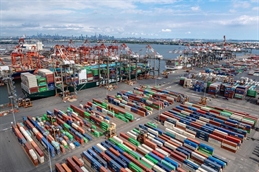
While the Canadian rail lockout of union employees that threatened to disrupt North American logistics has been abated, the possible ILA strike in the US East and Gulf coasts hangs in the balance, which could impact the North American supply chain in the usually busiest months of the year.
Judah Levine, head of research at Freightos, said the anticipation of the lockout in Canada's two major freight railroads did result in some diversions away from Vancouver, which contributed to worsening congestion at some terminals in Tacoma and a backlog created by the one-day shutdown could take about a week to clear.
"Meanwhile, the possibility of an ILA port worker strike in October at East Coast and Gulf ports in the US still looms," he added.
Levine said this added urgency to ship goods from Asia in the hope of receiving them before the union contract expires, contributing some additional upward pressure on spot rates to the East Coast in the last few weeks.
"While ocean prices from Asia to N. Europe and the Mediterranean have eased about 8% each from their July peaks, rates to the East Coast have remained at their peak level since mid-July," the report said.
It added that there are also reports of some pull forward of transatlantic volumes ahead of the possible strike, though rates on this lane have remained level.
Prices to the West Coast—which had eased about 20% from their July peak as carriers added capacity to the lane and demand may already be past its peak—climbed by more than 10% last week on mid-month GRIs by some carriers.
"More reports that carriers are offering some discounted rates relative to spot levels support scepticism that these or further increases will stick," Levine said.
"If there is a strike in October, though, rates to the West Coast would likely increase as shippers shift volumes away from the East Coast and as a backlog of containers and vessels at East Coast and Gulf ports ties up capacity," he added.
Meanwhile, in India, a port worker union representing 20,000 members reached a last-minute agreement with port operators this week, avoiding a strike that would shut down the country's twelve largest ports.
Levine said a strike would have created a rebound in backlogs and congestion just as demand has started to ease and operations have improved recently, as reflected in some carriers deciding to cancel or reduce planned surcharges.
"Logistics operations in Bangladesh, where ports were making progress clearing backlogs caused by the political upheaval in June and July, now face new challenges as devastating floods last week are impacting road logistics and slowing the transport of containers to and from Chittagong," the Freightos head of research added.
Rates expected to be higher later in the year
In air cargo, US Customs and Border Protection is reportedly increasing its scrutiny and expectations of customs brokers and may tighten reporting requirements for imports entering via the de minimis exception as it seeks to better regulate the flood of e-commerce shipments from China that arrive mostly by air.
"Even with stricter requirements, though, most observers expect B2C e-commerce shipments to remain a major factor in air cargo demand and contribute to a strong Q4 peak season for air," Levine said.
Though summer is typically a slow season for air cargo, e-commerce volumes have kept space tight and rates at levels usually reserved for peak season.
Freightos Air Index rates out of China were above US$6.00/kg to N. America last week and at about US$3.50/kg to Europe.
"With rates already elevated, expectations are for even higher prices and tighter capacity when demand increases later in the year," the head of research at Freightos further said.



